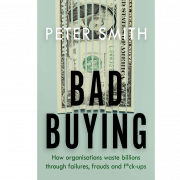UK Government Spend With Smaller Firms Declines
Without fanfare or comment, in the middle of the holiday season, the UK government recently published the data for spend with SMEs (small and medium enterprises) for 2021/22. This covers central departments, and some associated bodies, although the definition of what is in and what is out is not always clear. The data is given as direct spend – money that goes straight to the small firms – and indirect, the spend that goes via larger firms that then use SMEs in their supply chain.
It is not unusual for it to take over a year from the end of the period in question before data is published. That is in part because it does take a while to gather the data, but I suspect the publication might have happened sooner if there had been a positive story to tell.
But the headline number was that SME percentage spend declined in 2021/22 compared to 2020/21. The total was down from 26.9% to 26.5%, and the direct spend was down from 14.2% to 12.3%. That does not look good against the government target of 33% of spend.
Indirect spend was up by 1.4% but that was not enough to compensate for the drop in direct spend. It looks like the main reason for the overall decline was a big drop in the Department of Health and Social Care (DHSC) SME spend year on year. I suspect that is the “PPE effect” – as we know, there was lots of PPE bought in 2020 and 2021 from smaller firms. They were often crooks, chancers and friends of ministers, but they were SMEs, nonetheless.
Until the pandemic, the DHSC spend was relatively small compared to MOD and Transport – the two “traditional” big spenders. Most health spend was out in the Trusts so not captured in this data. But the huge amount of “central “ buying, on PPE but also track and trace and other projects, pushed up the significance of DHSC in the overall numbers.
In 2019/20, DHSC spend was just £3.1 billion against MOD’s £21.1 billion. But the figure shot up to £13.3B in 20/21 (MOD was £19.5B) and was still £11.5B in 21/22. In 20/21, 23.3% of the DHSC total was direct SME spend, so that made the year look better, but by 21/22 that dropped to 14.2%, pulling down the whole percentage.
I’m going into some detail there because it does demonstrate how ridiculous looking at the overall number actually is. When one factor – PPE – in one Department can skew the whole data set, it is pretty useless. But let’s go back in time and look at how this target emerged.
Supporting smaller firms was one of the first “social value” type issues government embraced. I worked in the Office of Government Commerce (part of Treasury, the UK finance ministry) as a consultant back in 2009 on the implementation of the 2008 Glover report – “Accelerating the SME economic engine: through transparent, simple and strategic procurement”. (That link took some finding!)
But Sally Collier (OGC’s Policy director) and I didn’t really like the idea of targets for spend with SMEs for various reasons. One was the difficulty of setting sensible targets, which really needed to vary by department to be meaningful. We were interested in departments and buyers simply doing the right things, and therefore also worried that targets would mean effort going into the data, not the real action. But our advice was ignored and after the 2010 election a 25% target was set.
It quickly emerged that 25% was unachievable. The Ministry of Defence and the Highways Agency (Transport) accounted for almost half of central government procurement spend and there was no way an SME was going to build a warship or the M25 motorway. So the target was changed to an “aspiration”, a classic Francis Maude fudge, and then indirect spend was included to make it easier to hit the target.
But many of the first-tier suppliers to government have no idea really how much they spend with SMEs, so the data is pretty dodgy. Then the 25% target – which had never been achieved – was stupidly changed in 2015 to 33%, purely because the Cameron government wanted to say something positive for the “small business” lobby in their election manifesto. And 33% is unachievable too, as we’ve seen, even including indirect spend.
The other issue is whether supporting SMEs is the right target today. We have become much more sophisticated in the 15 years since Glover and now most large private firms are interested in supporting diverse suppliers, not simply small firms.
So why not shift the focus to using government procurement to support charities and social enterprises, minority owned firms, innovative businesses, firms in deprived areas or those that employ lots of disabled people? You don’t see Unilever or other admired private sector businesses defining some prospective suppliers as special just because they are small. Indeed, many SMEs are small because they want to be, or because they just aren’t very good.
But there has been good work in government over the years in terms of helping SMEs. For example, even back in 2009, MOD led some impressive initiatives to promote SMEs through their supply chain. But really, this element of public procurement policy is crying out for a refresh, a more nuanced set of objectives and – if we must have targets – something that is realistic and motivating, not a painful data collection exercise that is bound to end in failure.









Leave a Reply
Want to join the discussion?Feel free to contribute!